Proteomic Analysis of Thin Filament Components Elucidates Changes in Spastic Muscle Sarcomere After Stroke
Abstract
1. Introduction
2. Results
2.1. Evaluation of Successful Establishment of Post-Stroke Muscle Spasm Model in Rats
2.1.1. Gait
2.1.2. Zea-Longa Score
2.1.3. Muscle Tone Detection
2.2. Changes in Sarcomere Length and Width After Stroke
2.3. Proteomic Analysis
2.4. Screening of Differentially Expressed Proteins
2.5. GO Annotation
2.6. KOG Annotation
2.7. Subcellular Location Analysis
2.8. Protein–Protein Interaction Analysis
3. Discussion
4. Materials and Methods
4.1. Experimental Animals and Ethics
4.2. Construction of Post-Stroke Muscle Spasm Model in SD Rats
4.3. Mallory’s Phosphotungstic Acid-Hematoxylin Stain
4.4. Protein Extraction and Digestion
4.5. Liquid Chromatography-Tandem Mass Spectrometry Analysis and Database Search
4.6. Bioinformatics Analysis
4.7. Statistical Processing
5. Conclusions
Author Contributions
Funding
Institutional Review Board Statement
Data Availability Statement
Conflicts of Interest
References
- Feigin, V.L.; Brainin, M.; Norrving, B.; Martins, S.O.; Pandian, J.; Lindsay, P.; Grupper, M.F.; Rautalin, I. World Stroke Organization: Global Stroke Fact Sheet 2025. Int. J. Stroke 2025, 20, 132–144. [Google Scholar] [CrossRef]
- Zeng, H.; Chen, J.; Guo, Y.; Tan, S. Prevalence and risk factors for spasticity after stroke: A systematic review and meta-analysis. Front. Neurol. 2021, 11, 616097. [Google Scholar] [CrossRef]
- Tsai, L.C.; Wu, Y.N.; Liu, S.Q.; Zhang, L.Q. Changes in muscle stress and sarcomere adaptation in mice following ischemic stroke. Front. Physiol. 2020, 11, 581846. [Google Scholar] [CrossRef]
- Granzier, H.L.; Akster, H.A.; Ter Keurs, H.E. Effect of thin filament length on the force-sarcomere length relation of skeletal muscle. Am. J. Physiol. 1991, 260 Pt 1, C1060–C1070. [Google Scholar] [CrossRef]
- Kolb, J.; Li, F.; Methawasin, M.; Adler, M.; Escobar, Y.N.; Nedrud, J.; Pappas, C.T.; Harris, S.P.; Granzier, H. Thin filament length in the cardiac sarcomere varies with sarcomere length but is independent of titin and nebulin. J. Mol. Cell Cardiol. 2016, 97, 286–294. [Google Scholar] [CrossRef]
- González Morales, N.; Marescal, O.; Szikora, S.; Katzemich, A.; Correia-Mesquita, T.; Bíró, P.; Erdelyi, M.; Mihály, J.; Schöck, F. The oxoglutarate dehydrogenase complex is involved in myofibril growth and Z-disc assembly in Drosophila. J. Cell Sci. 2023, 136, jcs260717. [Google Scholar] [CrossRef]
- Littlefield, R.S.; Fowler, V.M. Thin filament length regulation in striated muscle sarcomeres: Pointed-end dynamics go beyond a nebulin ruler. Semin. Cell Dev. Biol. 2008, 19, 511–519. [Google Scholar] [CrossRef]
- Tsukada, T.; Pappas, C.T.; Moroz, N.; Antin, P.B.; Kostyukova, A.S.; Gregorio, C.C. Leiomodin-2 is an antagonist of tropomodulin-1 at the pointed end of the thin filaments in cardiac muscle. J. Cell Sci. 2010, 123, 3136–3145. [Google Scholar] [CrossRef]
- Gonzalez-Morales, N.; Xiao, Y.S.; Schilling, M.A.; Marescal, O.; Liao, K.A.; Schöck, F. Myofibril diameter is set by a finely tuned mechanism of protein oligomerization in Drosophila. eLife 2019, 8, e50496. [Google Scholar] [CrossRef]
- Gateva, G.; Kremneva, E.; Reindl, T.; Kotila, T.; Kogan, K.; Gressin, L.; Gunning, P.W.; Manstein, D.J.; Michelot, A.; Lappalainen, P. Tropomyosin isoforms specify functionally distinct actin filament populations in vitro. Curr. Biol. 2017, 27, 705–713. [Google Scholar] [CrossRef]
- Yang, S.; Liu, C.; Guo, Y.; Li, G.; Li, D.; Yan, X.; Zhu, X. Self-construction of actin networks through phase separation-induced abLIM1 condensates. Proc. Natl. Acad. Sci. USA 2022, 119, e2122420119. [Google Scholar] [CrossRef]
- Robaszkiewicz, K.; Wróbel, J.; Moraczewska, J. Troponin and a myopathy-linked mutation in TPM3 inhibit cofilin-2-induced thin filament depolymerization. Int. J. Mol. Sci. 2023, 24, 16457. [Google Scholar] [CrossRef]
- Robaszkiewicz, K.; Śliwinska, M.; Moraczewska, J. Regulation of actin filament length by muscle isoforms of tropomyosin and cofilin. Int. J. Mol. Sci. 2020, 21, 4285. [Google Scholar] [CrossRef]
- Tolkatchev, D.; Gregorio, C.C.; Kostyukova, A.S. The role of leiomodin in actin dynamics: A new road or a secret gate. FEBS J. 2022, 289, 6119–6131. [Google Scholar] [CrossRef]
- Wu, T.; Mu, Y.; Bogomolovas, J.; Fang, X.; Veevers, J.; Nowak, R.B.; Pappas, C.T.; Gregorio, C.C.; Evans, S.M.; Fowler, V.M.; et al. HSPB7 is indispensable for heart development by modulating actin filament assembly. Proc. Natl. Acad. Sci. USA 2017, 114, 11956–11961. [Google Scholar] [CrossRef]
- Gokhin, D.S.; Kim, N.E.; Lewis, S.A.; Hoenecke, H.R.; D’Lima, D.D.; Fowler, V.M. Thin-filament length correlates with fiber type in human skeletal muscle. Am. J. Physiol. Cell Physiol. 2012, 302, C555–C565. [Google Scholar] [CrossRef]
- Tian, L.; Ding, S.; You, Y.; Li, T.R.; Liu, Y.; Wu, X.; Sun, L.; Xu, T. Leiomodin-3-deficient mice display nemaline myopathy with fast-myofiber atrophy. Dis. Model. Mech. 2015, 8, 635–641. [Google Scholar] [CrossRef]
- Guo, S.; Sokolova, O.S.; Chung, J.; Padrick, S.; Gelles, J.; Goode, B.L. Abp1 promotes Arp2/3 complex-dependent actin nucleation and stabilizes branch junctions by antagonizing GMF. Nat. Commun. 2018, 9, 2895. [Google Scholar] [CrossRef]
- Butkevich, E.; Bodensiek, K.; Fakhri, N.; Von Roden, K.; Schaap, I.A.; Majoul, I.; Schmidt, C.F.; Klopfenstein, D.R. Drebrin-like protein DBN-1 is a sarcomere component that stabilizes actin filaments during muscle contraction. Nat. Commun. 2015, 6, 7523. [Google Scholar] [CrossRef]
- Yamaji, S.; Suzuki, A.; Kanamori, H.; Mishima, W.; Yoshimi, R.; Takasaki, H.; Takabayashi, M.; Fujimaki, K.; Fujisawa, S.; Ohno, S.; et al. Affixin interacts with alpha-actinin and mediates integrin signaling for reorganization of F-actin induced by initial cell-substrate interaction. J. Cell Biol. 2004, 165, 539–551. [Google Scholar] [CrossRef]
- Sepulveda, J.L.; Wu, C. The parvins. Cell Mol. Life Sci. 2006, 63, 25–35. [Google Scholar] [CrossRef]
- Silacci, P.; Mazzolai, L.; Gauci, C.; Stergiopulos, N.; Yin, H.L.; Hayoz, D. Gelsolin superfamily proteins: Key regulators of cellular functions. Cell Mol. Life Sci. 2004, 61, 2614–2623. [Google Scholar] [CrossRef]
- Patel, V.B.; Zhabyeyev, P.; Chen, X.; Wang, F.; Paul, M.; Fan, D.; McLean, B.A.; Basu, R.; Zhang, P.; Shah, S.; et al. PI3Kα-regulated gelsolin activity is a critical determinant of cardiac cytoskeletal remodeling and heart disease. Nat. Commun. 2018, 9, 5390. [Google Scholar] [CrossRef]
- Zaner, K.S.; Hartwig, J.H. The effect of filament shortening on the mechanical properties of gel-filtered actin. J. Biol. Chem. 1988, 263, 4532–4536. [Google Scholar] [CrossRef]
- Zhang, Y.; Vorobiev, S.M.; Gibson, B.G.; Hao, B.; Sidhu, G.S.; Mishra, V.S.; Yarmola, E.G.; Bubb, M.R.; Almo, S.C.; Southwick, F.S. A CapG gain-of-function mutant reveals critical structural and functional determinants for actin filament severing. EMBO J. 2006, 25, 4458–4467. [Google Scholar] [CrossRef]
- Yu, F.X.; Johnston, P.A.; Südhof, T.C.; Yin, H.L. gCap39, a calcium ion- and polyphosphoinositide-regulated actin capping protein. Science 1990, 250, 1413–1415. [Google Scholar] [CrossRef]
- Ranta-aho, J.; Olive, M.; Vandroux, M.; Roticiani, G.; Dominguez, C.; Johari, M.; Torella, A.; Böhm, J.; Turon, J.; Nigro, V.; et al. Mutation update for the ACTN2 gene. Hum. Mutat. 2022, 43, 1745–1756. [Google Scholar] [CrossRef]
- Henderson, C.A.; Gomez, C.G.; Novak, S.M.; Mi-Mi, L.; Gregorio, C.C. Overview of the muscle cytoskeleton. Compr. Physiol. 2017, 7, 891–944. [Google Scholar] [CrossRef]
- Haug, M.; Reischl, B.; Nübler, S.; Kiriaev, L.; Mázala, D.A.; Houweling, P.J.; North, K.N.; Friedrich, O.; Head, S.I. Absence of the Z-disc protein α-actinin-3 impairs the mechanical stability of Actn3KO mouse fast-twitch muscle fibres without altering their contractile properties or twitch kinetics. Skelet. Muscle 2022, 12, 14. [Google Scholar] [CrossRef]
- Sanger, J.W.; Chowrashi, P.; Shaner, N.C.; Spalthoff, S.; Wang, J.; Freeman, N.L.; Sanger, J.M. Myofibrillogenesis in skeletal muscle cells. Clin. Orthop. Relat. Res. 2002, 403, S153–S162. [Google Scholar] [CrossRef]
- Wilson, J.M.; Loenneke, J.P.; Jo, E.; Wilson, G.J.; Zourdos, M.C.; Kim, J.S. The effects of endurance, strength, and power training on muscle fiber type shifting. J. Strength. Cond. Res. 2012, 26, 1724–1729. [Google Scholar] [CrossRef]
- Fisher, L.A.; Schöck, F. The unexpected versatility of ALP/Enigma family proteins. Front. Cell Dev. Biol. 2022, 10, 963608. [Google Scholar] [CrossRef] [PubMed]
- Vafiadaki, E.; Arvanitis, D.A.; Papalouka, V.; Terzis, G.; Roumeliotis, T.I.; Spengos, K.; Garbis, S.D.; Manta, P.; Kranias, E.G.; Sanoudou, D. Muscle lim protein isoform negatively regulates striated muscle actin dynamics and differentiation. FEBS J. 2014, 281, 3261–3279. [Google Scholar] [CrossRef] [PubMed]
- Horton, E.R.; Humphries, J.D.; James, J.; Jones, M.C.; Askari, J.A.; Humphries, M.J. The integrin adhesome network at a glance. J. Cell Sci. 2016, 129, 4159–4163. [Google Scholar] [CrossRef]
- Shi, G.X.; Yang, C.Y.; Wu, M.M.; Guan, L.P.; Wang, L.P.; Liu, C.Z. Muscle hypertonia after permanent focal cerebral ischemia in rats: A qualitative and quantitative behavioral and electrophysiological study. Int. J. Neurosci. 2013, 123, 575–581. [Google Scholar] [CrossRef]
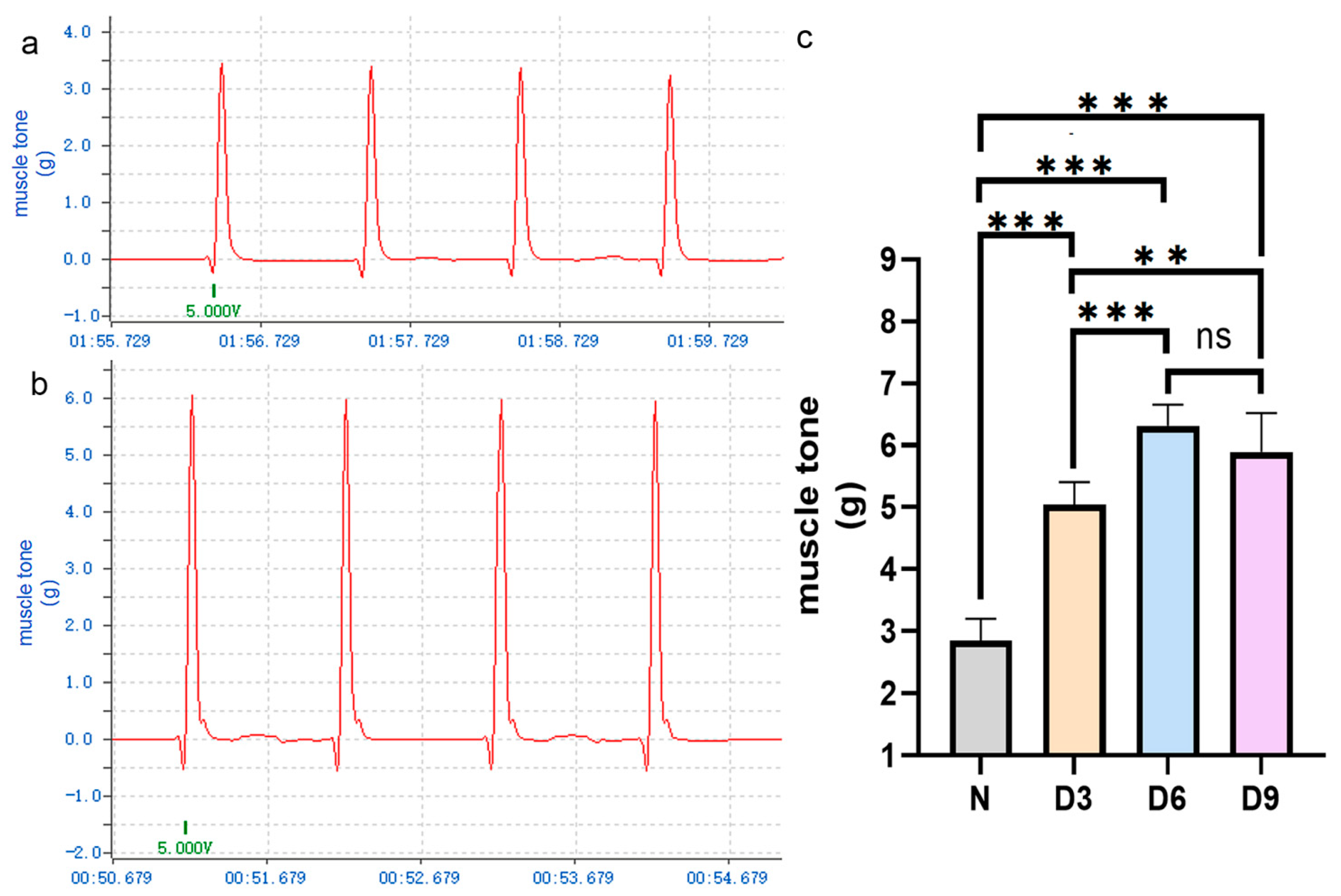
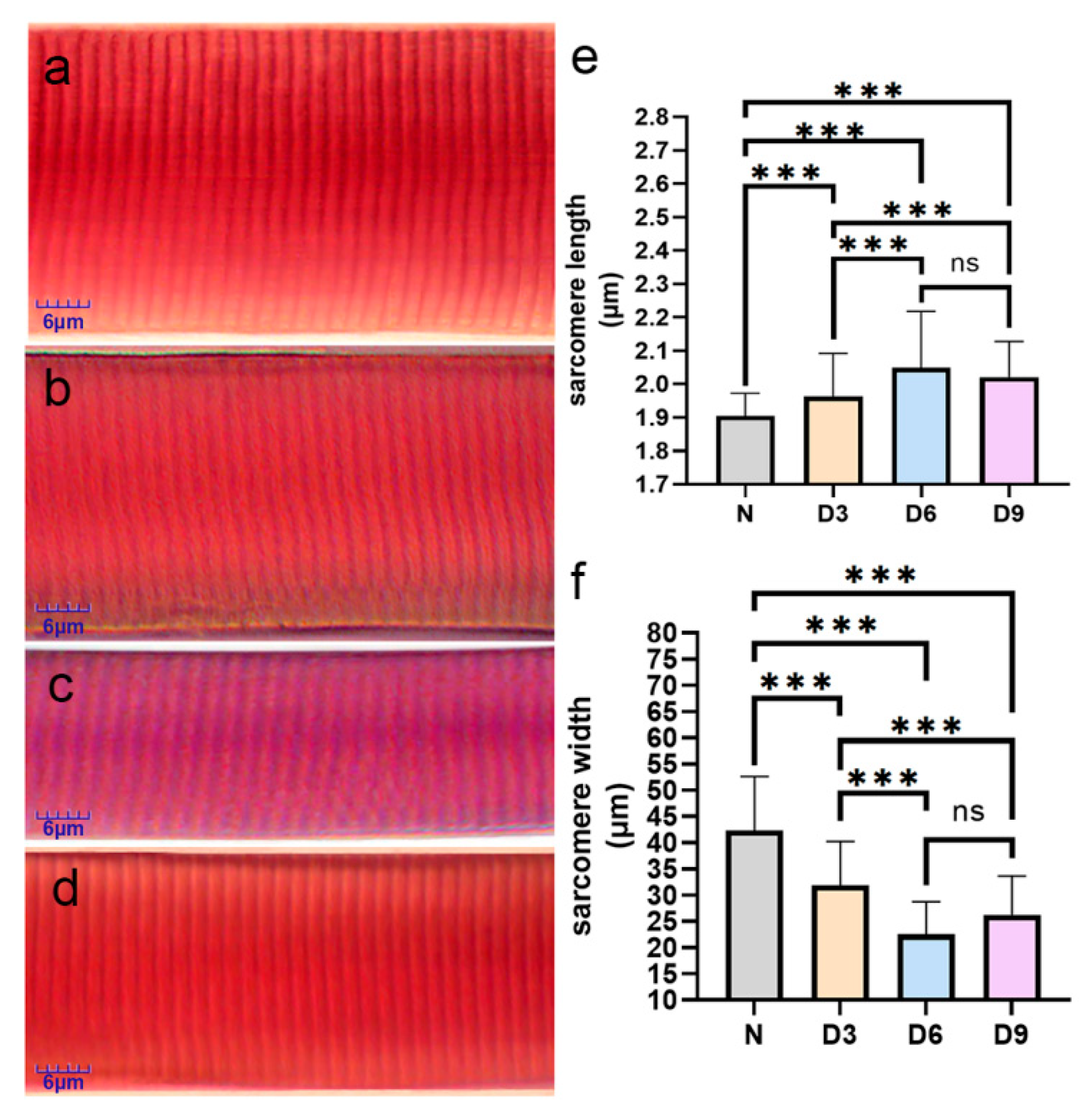

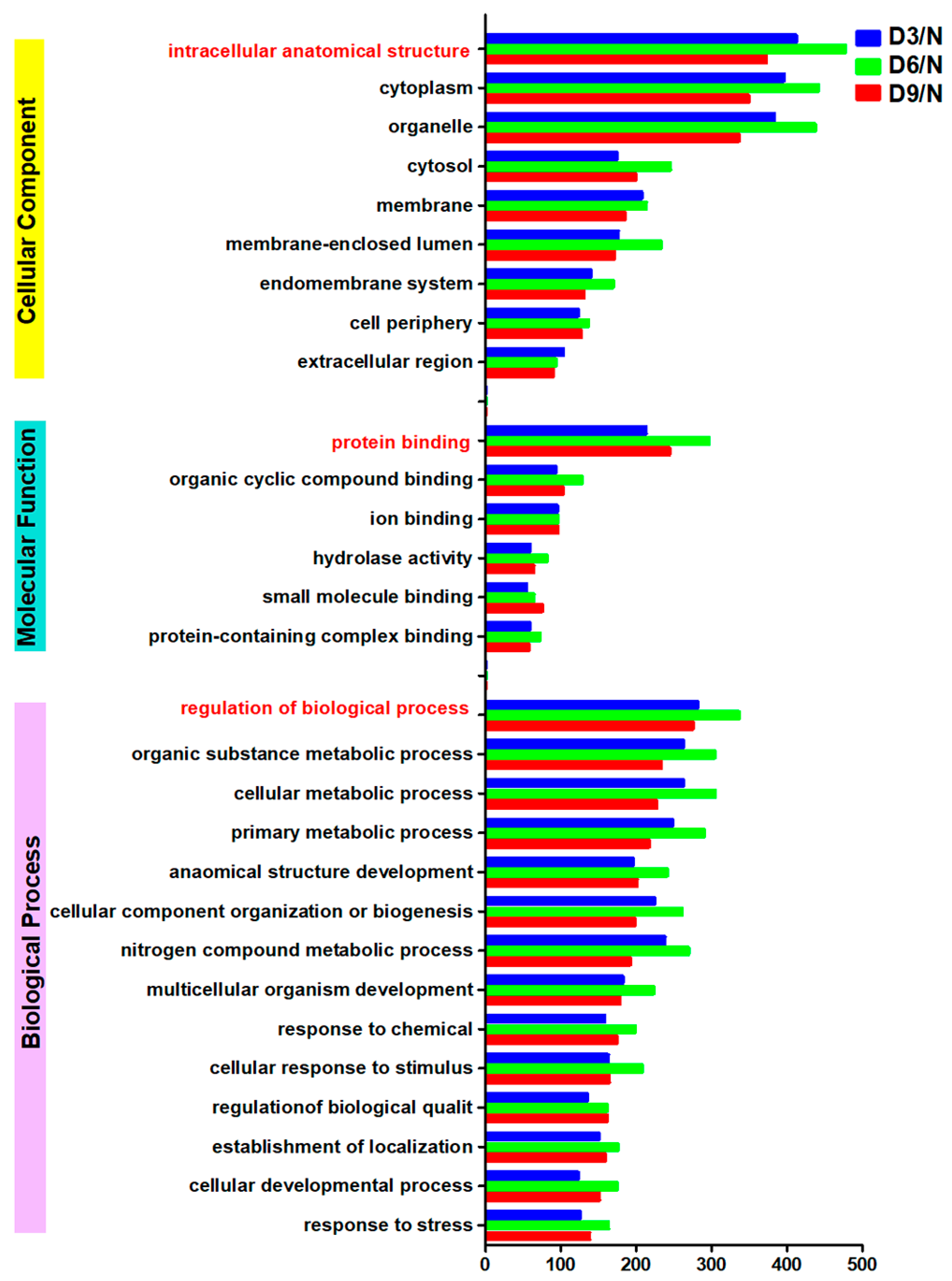
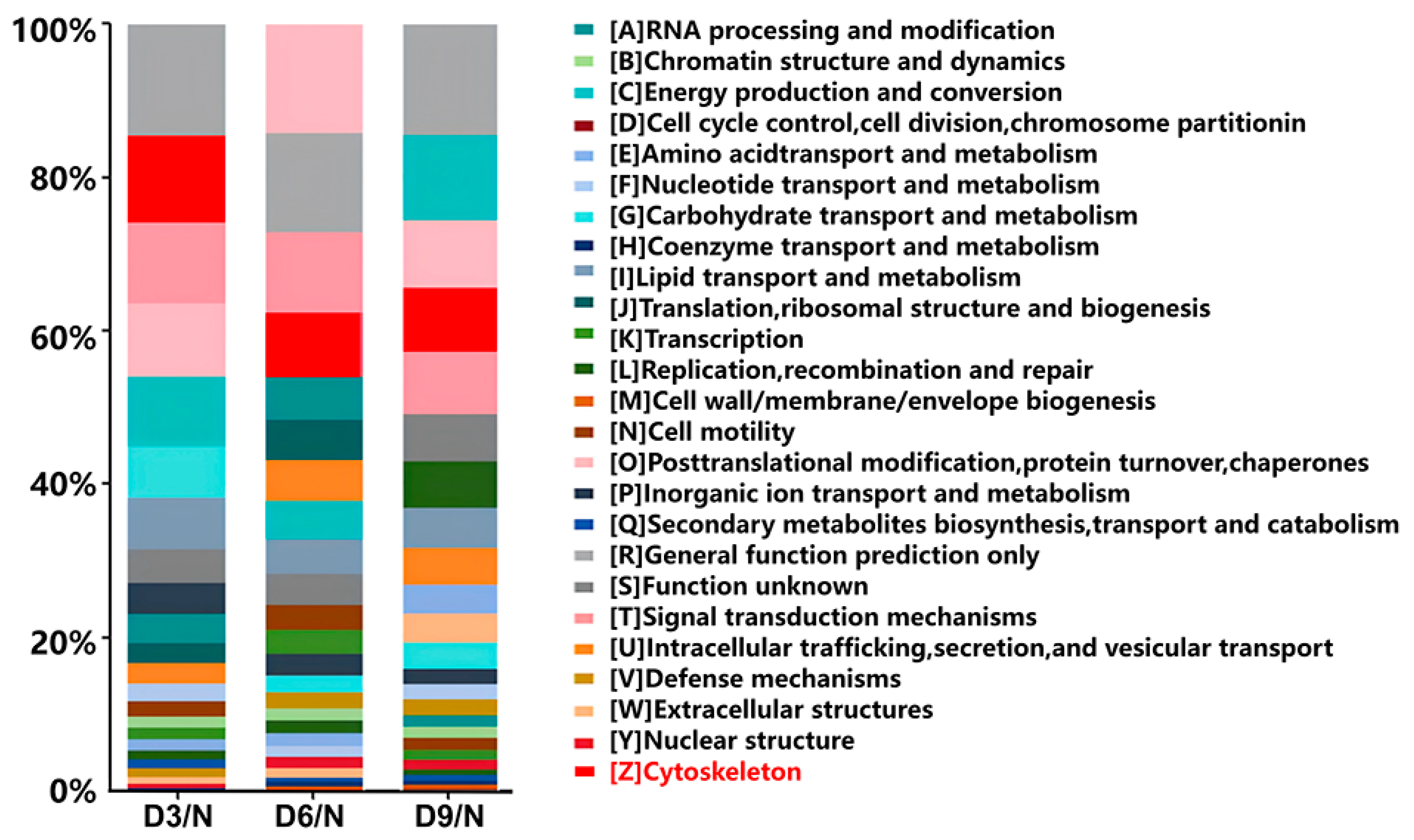
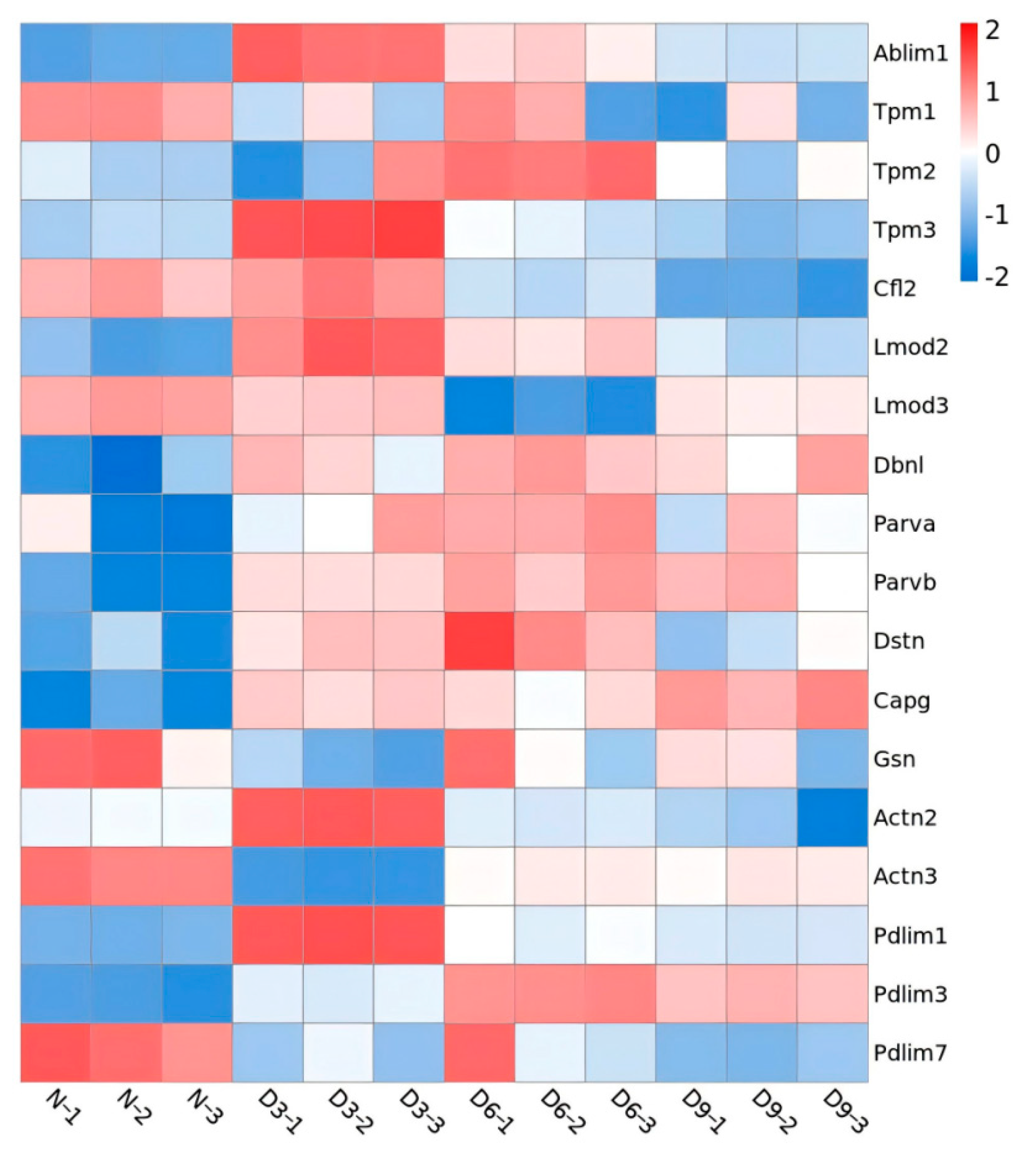
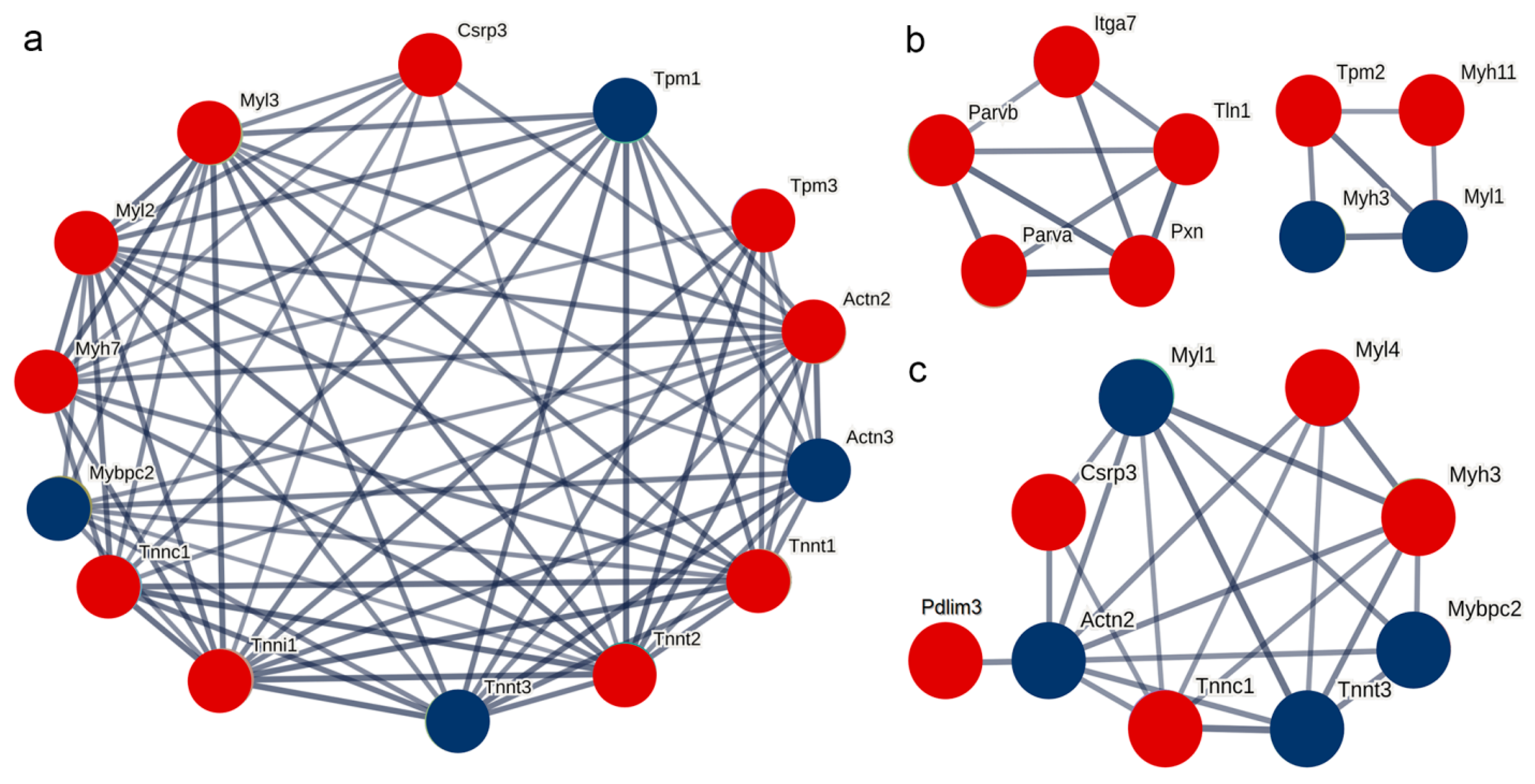
Disclaimer/Publisher’s Note: The statements, opinions and data contained in all publications are solely those of the individual author(s) and contributor(s) and not of MDPI and/or the editor(s). MDPI and/or the editor(s) disclaim responsibility for any injury to people or property resulting from any ideas, methods, instructions or products referred to in the content. |
© 2025 by the authors. Licensee MDPI, Basel, Switzerland. This article is an open access article distributed under the terms and conditions of the Creative Commons Attribution (CC BY) license (https://creativecommons.org/licenses/by/4.0/).
Share and Cite
He, Y.; Liu, G.; Wu, J.; Jiang, X.; Yang, S. Proteomic Analysis of Thin Filament Components Elucidates Changes in Spastic Muscle Sarcomere After Stroke. Int. J. Mol. Sci. 2025, 26, 10356. https://doi.org/10.3390/ijms262110356
He Y, Liu G, Wu J, Jiang X, Yang S. Proteomic Analysis of Thin Filament Components Elucidates Changes in Spastic Muscle Sarcomere After Stroke. International Journal of Molecular Sciences. 2025; 26(21):10356. https://doi.org/10.3390/ijms262110356
Chicago/Turabian StyleHe, Yun, Guangrun Liu, Junxi Wu, Xiaolin Jiang, and Shengbo Yang. 2025. "Proteomic Analysis of Thin Filament Components Elucidates Changes in Spastic Muscle Sarcomere After Stroke" International Journal of Molecular Sciences 26, no. 21: 10356. https://doi.org/10.3390/ijms262110356
APA StyleHe, Y., Liu, G., Wu, J., Jiang, X., & Yang, S. (2025). Proteomic Analysis of Thin Filament Components Elucidates Changes in Spastic Muscle Sarcomere After Stroke. International Journal of Molecular Sciences, 26(21), 10356. https://doi.org/10.3390/ijms262110356



